The Fiat 500, returning to the American market after a long absence, and under the guardianship of Chrysler LLC, is cute, fun to drive and well-executed.
But are American motorists ready yet for an “A-sized” vehicle?
That’s the big question for Fiat, Chrysler, the know-it-alls Inside the Beltway—and ultimately all the competitors in the U.S. market. Usually known as a City Car or by some, Urban Car, these tiny vehicles are defined by their short wheelbases—73.5 to 90.6 inches– and overall lengths between 106.1 and 139.6 inches.
At the moment the Fiat 500 is the largest of the City Car competitors in the U.S. market, the smallest being the Daimler Benz Smartfortwo and the just announced Toyota Scion iQ, in between in size. Still more are on the way, with Chevrolet getting ready to launch its new Spark, the smallest car it has ever offered.
These smallest cars on the American Road are not exactly creating a sales sensation. The 500 went on sale in April, chalking up 13,861 deliveries through September and the Smart fortwo, which has been around for several years as a kind of stepchild of Daimler, a mere 3,757 in nine months.
Larger “B” cars have fared better. For example, the 162-inch long Kia Soul sold 78,669 though September, followed by the 173.6-inch Fiesta at 57,725 and the 161.6-in long Honda Fit, 47,968.
The 2012 Fiat 500 is the reincarnation of the Fiat Topolino coupe first introduced to Benito Musolini’s Italian market in 1935. Two- place and “sporting” a tiny 569cc, 13 horsepower engine (hence its “500” designation), the car became a sort of Italian Model T Ford. Its very cuteness diverted American and Canadian troops slogging their way northward in Italy from 1943 to 1945 in brutal mountain fighting. A handful of Topolinos found their way to North America as “souvenirs.”
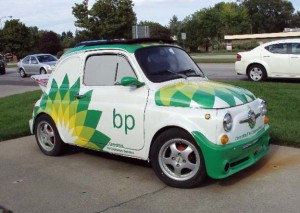
A previous generation of the 500 saw little demand from the U.S. and here serves as a Detroit gas station's billboard.
After World War II, there was a “B” model 500 makeover in 1948. The big change came with the Nuova Cinquecento (Italian for New 500) introduced in 1957 in true mass production, exported to many countries around the globe–though not many to the U.S., at the time awash in “bigger and better” cars.
The Italians fondly called this car the Chink (the way Cinque is pronounced in the land of the Romans) and it was said to be the first motorcar driven and owned for most people of the Mediterranean nation. Some 3.6 million Chinks were built from 1957 to 1975.
Although original Topolinos were equipped with a conventional four-cylinder inline engine, the “new” 500 of 1957 was powered by an air-cooled two-cylinder engine which varied in displacement from 479 to 595cc during the car’s 18-year life. The Fiat’s 479 produced an incredible 17-horsepower at the same time as America’s first horsepower race had Chevrolet zooming up to 345 horses. (That Chevy output seems tame today.)
If our 2012 Fiat 500 Sport media test vehicle were absolutely true to its heritage, its engine would call for it to be known as a Fiat 1400 rather than a 500, but really the 500 moniker fits better. On the other hand, it’s back to a more acceptable engine design for ease of complying with environmental restrictions. The 2012’s 1368 cc (83.5cid) inline four produces 101 hp with a 10.8:1 compression ratio; the block is cast iron while heads and “bedplate” are aluminum.
At my request, the test vehicle presented a neat five-speed-manual transmission, a chromed shift knob convenient to the driver’s hand. The easy shifting and upright “command driving position” of the 500 reminded me of the original Ford Fiesta introduced in Europe in 1976 and sold by U.S. Ford dealers 1979-80, of which the family had three in the early Eighties.
As an aside, the new Fiesta I drove last summer did not seem to me as fun to drive as the original. It’s also now a somewhat larger “B” class car. The original Fiesta did not sell well in the American market because there was no optional automatic transmission offered in a market characterized by less than ten percent demand for sticks. And anyway, Ford was developing the American Escort for 1981 model intro, complete with the needed automatic option.
My experience driving the Fiat 500 some 155 miles over a week in urban, suburban and interstate travel noted that fuel economy—as reported by the “instant” readout inside the neat concentric circle tach/speedometer–ranged from 27 to 37 in heavy stop-and-go traffic to well over 50 mpg on freeways at 70+ mph. Regular 87-octane gas is acceptable but pricier 91-octane is recommended for the 10.5 gallon (40 liter) tank.
The 500 presented no sense of driving a tiny City Car except for its ease of parking. The ride is surprisingly smooth and there is little choppiness despite the 90.6-inch wheelbase except on some poorly surfaced roads. The $17,500 Sport model was well-equipped with about every feature an American buyer would expect. Fiat 500s sold in the Americas are produced at Toluca, Mexico.
As noted earlier in this space, the 500 got top ratings from the Insurance Institute for Highway Safety following the usual laboratory crash tests. (Click Here for that story.) It seems equipped with every conceivable operational and occupant protection safety device but on the down side has little crush space from any direction. Air bags cannot make up for space in severe impacts, though they produce good lab test results.
All in all, I would be happy to own and drive a Fiat 500. It is perfect for zooming around town as long as there is no need for carrying adult-sized back seat passengers. The luggage space behind the rear seat seemed adequate for one person on a road trip, but the rear seat can be folded down for more capacity. Most of all, it is fun and easy to drive.

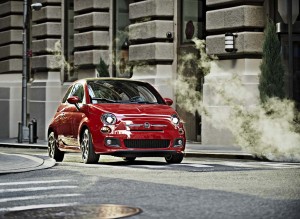
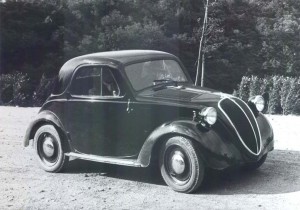
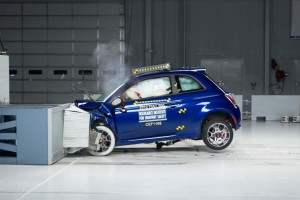
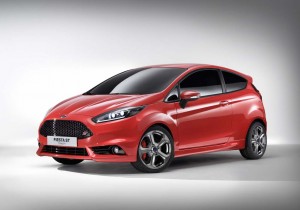
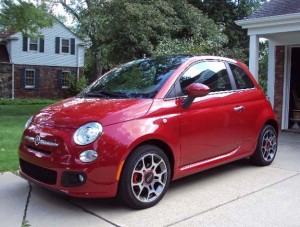
My 80 year-old uncle test drove the 500 and he was really impressed. So much so that he talked about his experience extensively. He especially thought it was roomy inside given the overall size of the car. He’s a Chrysler retiree and Italian, so he just had to give it a shot!